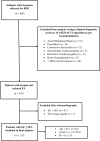Left atrial reservoir strain improves diagnostic accuracy of the 2016 ASE/EACVI diastolic algorithm in patients with preserved left ventricular ejection fraction: insights from the KARUM haemodynamic database
- PMID: 35182152
- PMCID: PMC9635061
- DOI: 10.1093/ehjci/jeac036
Left atrial reservoir strain improves diagnostic accuracy of the 2016 ASE/EACVI diastolic algorithm in patients with preserved left ventricular ejection fraction: insights from the KARUM haemodynamic database
Abstract
Aims: This study aimed to investigate the incremental value offered by left atrial reservoir strain (LASr) to the 2016 American Society of Echocardiography/European Association of Cardiovascular Imaging (ASE/EACVI) diastolic algorithm to identify elevated left ventricular (LV) filling pressure in patients with preserved ejection fraction (EF).
Methods and results: Near-simultaneous echocardiography and right heart catheterization were performed in 210 patients with EF ≥50% in a large, dual-centre study. Elevated filling pressure was defined as invasive pulmonary capillary wedge pressure (PCWP) ≥15 mmHg. LASr was evaluated using speckle-tracking echocardiography. Diagnostic performance of the ASE/EACVI diastolic algorithm was validated against invasive reference and compared with modified algorithms incorporating LASr. Modest correlation was observed between E/e', E/A ratio, and LA volume index with PCWP (r = 0.46, 0.46, and 0.36, respectively; P < 0.001 for all). Mitral e' and TR peak velocity showed no association. The ASE/EACVI algorithm (89% feasibility, 71% sensitivity, 68% specificity) demonstrated reasonable ability (AUC = 0.69) and 68% accuracy to identify elevated LV filling pressure. LASr displayed strong ability to identify elevated PCWP (AUC = 0.76). Substituting TR peak velocity for LASr in the algorithm (69% sensitivity, 84% specificity) resulted in 91% feasibility, 81% accuracy, and stronger agreement with invasive measurements. Employing LASr as per expert consensus (71% sensitivity, 70% specificity) and adding LASr to conventional parameters (67% sensitivity, 84% specificity) also demonstrated greater feasibility (98% and 90%, respectively) and overall accuracy (70% and 80%, respectively) to estimate elevated PCWP.
Conclusions: LASr improves feasibility and overall accuracy of the ASE/EACVI algorithm to discern elevated filling pressures in patients with preserved EF.
Keywords: diastolic dysfunction; echo Doppler; left ventricular filling pressure; right heart catheterization; speckle tracking echocardiography.
Published on behalf of the European Society of Cardiology. All rights reserved. © The Author(s) 2022. For permissions, please email: journals.permissions@oup.com.
Conflict of interest statement
Conflict of interest: A.V., H.O.T., and E.T. have no disclosures; U.L.F. received consulting honoraria from Orion Pharma and Anacardio; L.H.L. reports personal fees from Merck, grants and personal fees from Vifor-Fresenius, grants and personal fees from AstraZeneca, personal fees from Bayer, grants from Boston Scientific, personal fees from Pharmacosmos, personal fees from Abbott, personal fees from Medscape, personal fees from Myokardia, grants and personal fees from Boehringer Ingelheim, grants and personal fees from Novartis, personal fees from Sanofi, personal fees from Lexicon, personal fees from Radcliffe cardiology, outside the submitted work; P.L. reports fees from Pfizer.
Figures






References
-
- McDonagh TA, Metra M, Adamo M, Gardner RS, Baumbach A, Böhm Met al. ; ESC Scientific Document Group . 2021 ESC guidelines for the diagnosis and treatment of acute and chronic heart failure: developed by the task force for the diagnosis and treatment of acute and chronic heart failure of the European Society of Cardiology (ESC) with the special contribution of the Heart Failure Association (HFA) of the ESC. Eur Heart J 2021;42:3599–726. - PubMed
-
- Nagueh SF, Smiseth OA, Appleton CP, Byrd BF, Dokainish H, Edvardsen Tet al. . Recommendations for the evaluation of left ventricular diastolic function by echocardiography: an update from the American Society of Echocardiography and the European Association of Cardiovascular Imaging. Eur J Echocardiogr 2016;17:1321–60. - PubMed
-
- Nauta JF, Hummel YM, van der Meer P, Lam CS, Voors AA, van Melle JP.. Correlation with invasive left ventricular filling pressures and prognostic relevance of the echocardiographic diastolic parameters used in the 2016 ESC heart failure guidelines and in the 2016 ASE/EACVI recommendations: a systematic review in patients with heart failure with preserved ejection fraction. Eur J Heart Fail 2018;20:1303–11. - PubMed
-
- Berthelot E, Jourdain P, Tam Bailly M, Bouchachi A, Gellen B, Rouquette Aet al. . Echocardiographic evaluation of left ventricular filling pressure in patients with heart failure with preserved ejection fraction: usefulness of inferior vena cava measurements and 2016 EACVI/ASE recommendations. J Card Fail 2020;26:507–14. - PubMed
-
- Hummel YM, Liu LC, Lam CS, Fonseca‐Munoz DF, Damman K, Rienstra Met al. . Echocardiographic estimation of left ventricular and pulmonary pressures in patients with heart failure and preserved ejection fraction: a study utilizing simultaneous echocardiography and invasive measurements. Eur J Heart Fail 2017;19:1651–60. - PubMed

